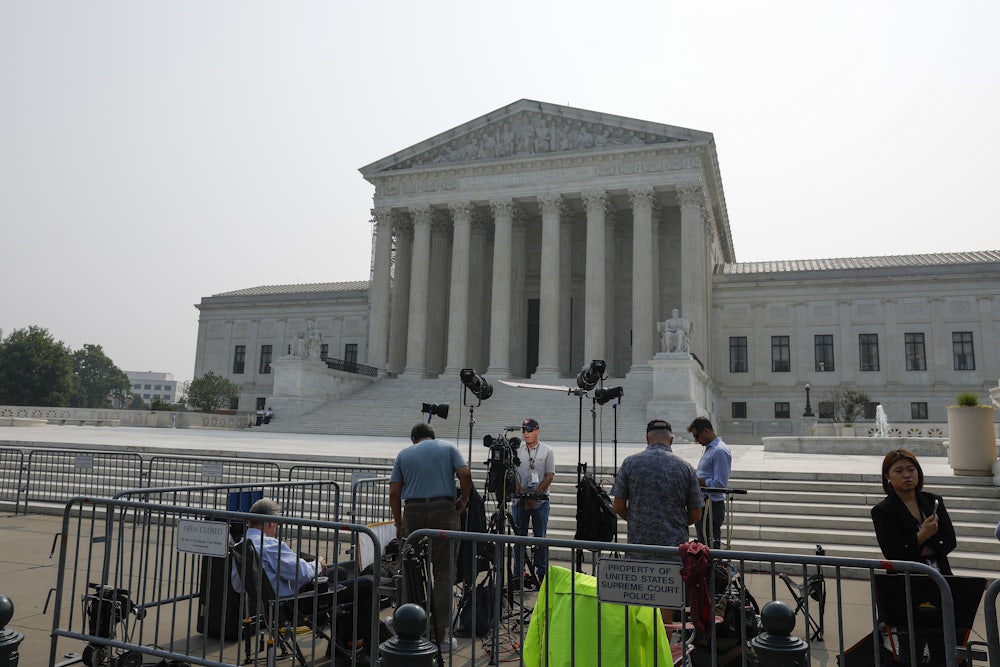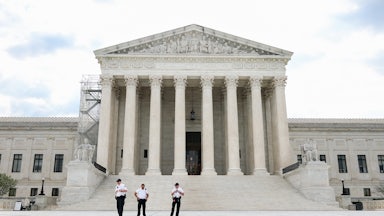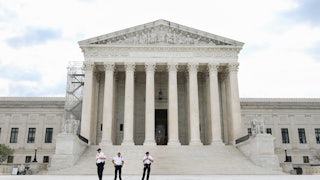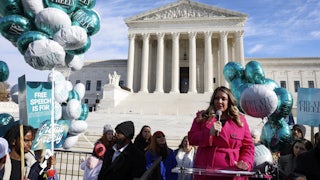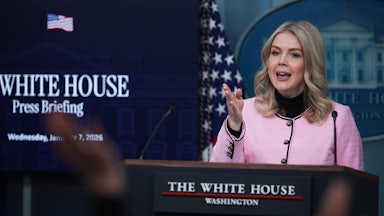The Supreme Court effectively ended the nation’s half-century experiment with affirmative action in college admissions on Thursday, ruling that the policies used by Harvard University and the University of North Carolina violated the Fourteenth Amendment. The decision, which fell along the court’s usual ideological lines, will reopen the legal battlefield over diversity and college admissions.
Chief Justice John Roberts, writing for the court, concluded that the schools’ approach “cannot be reconciled with the guarantees of the Equal Protection Clause” and must be overturned. “Both programs lack sufficiently focused and measurable objectives warranting the use of race, unavoidably employ race in a negative manner, involve racial stereotyping, and lack meaningful endpoints. We have never permitted admissions programs to work in that way, and we will not do so today.”
The court’s liberals denounced the majority for blocking remedies for persistent racial disparities. “In so holding, the Court cements a superficial rule of colorblindness as a constitutional principle in an endemically segregated society where race has always mattered and continues to matter,” Justice Sonia Sotomayor wrote in the primary dissent. “The Court subverts the constitutional guarantee of equal protection by further entrenching racial inequality in education, the very foundation of our democratic government and pluralistic society.”
At issue in the case was more than just whether a particular student gets into the university of their choice. The justices’ opinions are driven by two fundamentally different visions of the Constitution: one in which the Reconstruction Amendments created tools to remedy generations of racial injustice, and one in which the Fourteenth Amendment’s equal protection clause set out to create a colorblind Constitution—and, through it, a colorblind society.
That divide came out most sharply in dueling writings between Justices Clarence Thomas and Ketanji Brown Jackson, the court’s two Black justices. Thomas has written at length, both on the court and in his biography, about his hostility toward affirmative action programs and his frustration with how they shaped his life. To that end, he wrote a 58-page concurrence—substantially longer than Roberts’s majority opinion—to explain how his vision of a color-blind Constitution was the proper originalist understanding of the Fourteenth Amendment.
“While I am painfully aware of the social and economic ravages which have befallen my race and all who suffer discrimination, I hold out enduring hope that this country will live up to its principles so clearly enunciated in the Declaration of Independence and the Constitution of the United States: that all men are created equal, are equal citizens, and must be treated equally before the law,” Thomas concluded.
Jackson, who recused herself from the Harvard portion because she had served on the school’s Board of Overseers, condemned the majority for its “ostrich-like” approach to racism and its continuing influence on American society. “With let-them-eat-cake obliviousness, today, the majority pulls the ripcord and announces ‘colorblindness for all’ by legal fiat,” she wrote. “But deeming race irrelevant in law does not make it so in life. And having so detached itself from this country’s actual past and present experiences, the court has now been lured into interfering with the crucial work that UNC and other institutions of higher learning are doing to solve America’s real-world problems.”
The cases, Students for Fair Admissions v. UNC and Students for Fair Admissions v. Harvard, came about as part of a campaign by Edward Blum, a conservative legal activist who also orchestrated a successful challenge to the Voting Rights Act of 1965 in Shelby County v. Holder. His organization claimed to represent thousands of college students who believed they were unfairly denied admission to their university of choice based on race-conscious admissions policies at those schools, favoring other students.
Both Harvard and UNC maintained policies that allowed university employees to consider race as a factor for admissions at various points during the admissions process. The schools defended those policies by arguing that they would create a more diverse student body, furthering the schools’ basic educational goals and preparing future generations of American political, business, and scientific leaders for life in a diverse, multiracial society.
SFFA challenged UNC’s policies on equal-protection grounds as a public university and under Title VI of the Civil Rights Act of 1964, which forbids racial discrimination by colleges that receive federal funds. While Harvard is not bound by the Fourteenth Amendment as a private university, it does receive federal funds and therefore falls under Title VI. SFFA additionally argued that Harvard’s policies effectively discriminated against Asian applicants by making it statistically less likely for them to obtain admission.
The Fourteenth Amendment’s Equal Protection Clause generally forbids de jure racial discrimination. Laws and policies that nonetheless discriminate on the basis of race are viewed with what is known as strict scrutiny by the courts. Strict scrutiny is the highest threshold of judicial review; it is roughly as fatal as Ebola. Under the Supreme Court’s precedents, the government must prove that the law or policy in question is necessary to further a compelling state interest, that it is narrowly tailored to the problem at hand, and that no other options are available.
Since the civil rights era of the 1960s, federal courts have been extremely reluctant to allow any race-based laws to survive strict scrutiny. Affirmative action in college admissions was the most notable exception. In 1978, the Supreme Court ruled in Regents of the University of California v. Bakke that a diverse student body was a compelling state interest. While the court said that racial quotas could not be used in college admissions, the justices left the door open for most affirmative-action programs to continue. Justice Lewis Powell, writing for the court, ruled that race could be considered as one of multiple factors in the admissions process.
Bakke was a deeply fractured ruling, however. Six justices, including Powell, wrote separately to concur and dissent from the ruling, and only a narrow slice of Powell’s conclusion commanded a five-justice majority. In 2003, the court returned to the matter in Grutter v. Bollinger, where it again upheld some race-conscious admissions programs in a 5–4 ruling. According to biographer Evan Thomas, Justice Sandra Day O’Connor joined the majority after being persuaded by friend-of-the-court briefs that such programs were necessary to ensure that future American business, political, and military leaders resembled the rest of the country.
But O’Connor’s support was not unconditional. Writing for the court, she explained that the Equal Protection Clause could not tolerate affirmative action in college admissions forever. “The Court takes the Law School at its word that it would like nothing better than to find a race-neutral admissions formula and will terminate its use of racial preferences as soon as practicable,” O’Connor declared. “The Court expects that 25 years from now, the use of racial preferences will no longer be necessary to further the interest approved today.” Thursday’s ruling came five years early.
Litigation against affirmative-action programs continued even after Grutter, Blum, who spearheaded Thursday’s case, previously organized a challenge to the University of Texas system’s admissions policies on equal-protection grounds through a student named Abigail Fisher. After lengthy litigation, the court rejected that argument in 2016 and upheld that school’s use of race as constitutional under Grutter. Two of the justices in the Fisher majority, Anthony Kennedy and Ruth Bader Ginsburg, were subsequently replaced by nominees chosen by former President Donald Trump. Their departure paved the way for Thursday’s ruling.
While affirmative action is over, this is nowhere near the end of the debate over diversity and college admissions. Roberts, writing for the majority, notably declined to address whether the court’s reasoning on public and private universities would extend to the nation’s military academies. “No military academy is a party to these cases, however, and none of the courts below addressed the propriety of race-based admissions systems in that context,” he wrote. “This opinion also does not address the issue, in light of the potentially distinct interests that military academies may present.”
The chief justice also gave conflicting signals about what happens if a college applicant proactively mentions their race during the admissions process. “Nothing in this opinion should be construed as prohibiting universities from considering an applicant’s discussion of how race affected his or her life, be it through discrimination, inspiration, or otherwise,” he wrote. “But, despite the dissent’s assertion to the contrary, universities may not simply establish through application essays or other means the regime we hold unlawful today.” The gulf between those two sentences will likely invite future litigation.
Another looming question is what happens if colleges adopt race-neutral measures to craft a more diverse student body. In May, a three-judge panel on the Fourth Circuit Court of Appeals upheld an admissions program by an elite high school in Virginia that used color-blind measures to boost diversity, including prioritizing students from impoverished backgrounds or middle schools that were “historically underrepresented” at the high school and abandoning standardized tests.
In a concurring opinion, one of the judges on the panel expressed concern with the implications of the legal challenge to that school’s admissions policy. “Having spent decades telling school officials they must consider race-neutral methods for ensuring a diverse student body before turning to race-conscious ones, it would be quite the judicial bait-and-switch to say such race-neutral efforts are also presumptively unconstitutional,” Judge Toby Heytens wrote.
Even if the court does not review that specific case, it will likely feel compelled to address the question somewhere down the road. While Thursday’s case marks the end of formal affirmative-action programs, efforts to build a more pluralistic society will likely continue—and be contested. “Notwithstanding this Court’s actions, however, society’s progress toward equality cannot be permanently halted,” Sotomayor wrote in her dissent. “Diversity is now a fundamental American value, housed in our varied and multicultural American community that only continues to grow. The pursuit of racial diversity will go on.”
